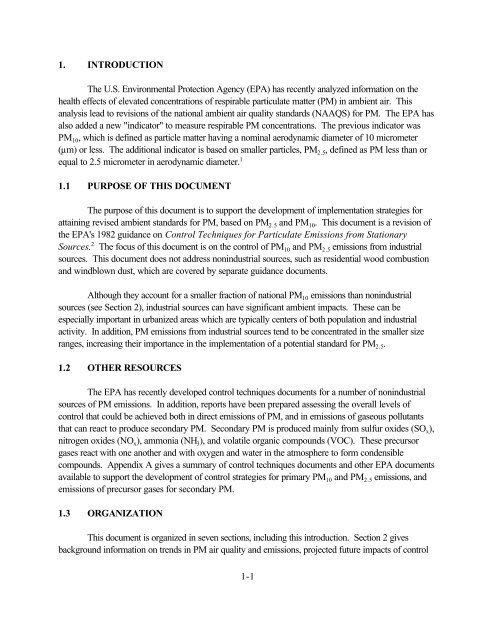Stationary Source Control Techniques Document for Fine Particulate ...
Stationary Source Control Techniques Document for Fine Particulate ...
Stationary Source Control Techniques Document for Fine Particulate ...
Create successful ePaper yourself
Turn your PDF publications into a flip-book with our unique Google optimized e-Paper software.
1. INTRODUCTION<br />
The U.S. Environmental Protection Agency (EPA) has recently analyzed in<strong>for</strong>mation on the<br />
health effects of elevated concentrations of respirable particulate matter (PM) in ambient air. This<br />
analysis lead to revisions of the national ambient air quality standards (NAAQS) <strong>for</strong> PM. The EPA has<br />
also added a new "indicator" to measure respirable PM concentrations. The previous indicator was<br />
PM 10, which is defined as particle matter having a nominal aerodynamic diameter of 10 micrometer<br />
(µm) or less. The additional indicator is based on smaller particles, PM 2.5, defined as PM less than or<br />
equal to 2.5 micrometer in aerodynamic diameter. 1<br />
1.1 PURPOSE OF THIS DOCUMENT<br />
The purpose of this document is to support the development of implementation strategies <strong>for</strong><br />
attaining revised ambient standards <strong>for</strong> PM, based on PM 2.5 and PM 10. This document is a revision of<br />
the EPA's 1982 guidance on <strong>Control</strong> <strong>Techniques</strong> <strong>for</strong> <strong>Particulate</strong> Emissions from <strong>Stationary</strong><br />
<strong>Source</strong>s. 2 The focus of this document is on the control of PM 10 and PM 2.5 emissions from industrial<br />
sources. This document does not address nonindustrial sources, such as residential wood combustion<br />
and windblown dust, which are covered by separate guidance documents.<br />
Although they account <strong>for</strong> a smaller fraction of national PM 10 emissions than nonindustrial<br />
sources (see Section 2), industrial sources can have significant ambient impacts. These can be<br />
especially important in urbanized areas which are typically centers of both population and industrial<br />
activity. In addition, PM emissions from industrial sources tend to be concentrated in the smaller size<br />
ranges, increasing their importance in the implementation of a potential standard <strong>for</strong> PM 2.5.<br />
1.2 OTHER RESOURCES<br />
The EPA has recently developed control techniques documents <strong>for</strong> a number of nonindustrial<br />
sources of PM emissions. In addition, reports have been prepared assessing the overall levels of<br />
control that could be achieved both in direct emissions of PM, and in emissions of gaseous pollutants<br />
that can react to produce secondary PM. Secondary PM is produced mainly from sulfur oxides (SO x),<br />
nitrogen oxides (NO x), ammonia (NH 3), and volatile organic compounds (VOC). These precursor<br />
gases react with one another and with oxygen and water in the atmosphere to <strong>for</strong>m condensible<br />
compounds. Appendix A gives a summary of control techniques documents and other EPA documents<br />
available to support the development of control strategies <strong>for</strong> primary PM 10 and PM 2.5 emissions, and<br />
emissions of precursor gases <strong>for</strong> secondary PM.<br />
1.3 ORGANIZATION<br />
This document is organized in seven sections, including this introduction. Section 2 gives<br />
background in<strong>for</strong>mation on trends in PM air quality and emissions, projected future impacts of control<br />
1-1

















